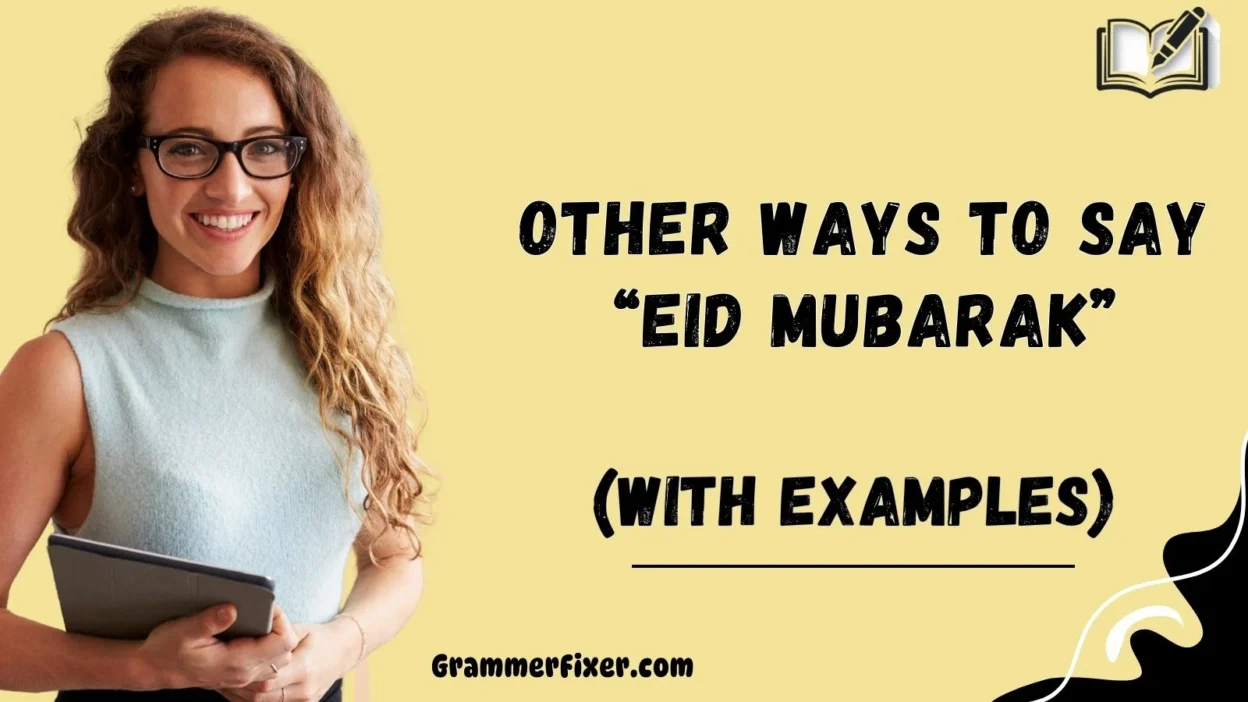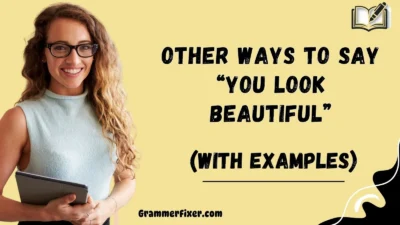Finding the right words to express care and warmth during Eid celebrations can make a simple message feel deeply personal and memorable. While “Eid Mubarak” is the classic greeting, sometimes you may want to add variety, deeper sentiment, or a personal touch.
This guide explores 30 heartfelt alternatives, complete with meanings, scenarios, and tones, so you can choose the perfect words for family, friends, colleagues, or communities.
What Does “Eid Mubarak” Mean?
The phrase “Eid Mubarak” is an Arabic greeting that translates to “Blessed Eid”. It is commonly used during Islamic festivals like Eid al-Fitr and Eid al-Adha to spread joy, peace, and blessings among loved ones.
When to Use “Eid Mubarak”?
You can use “Eid Mubarak” in both personal and professional settings. It works well in spoken conversations, text messages, greeting cards, and social media posts. The greeting is universally recognized across the Muslim world and appreciated by anyone familiar with Islamic traditions.
Is It Professional/Polite to Say “Eid Mubarak”?
Yes. Saying “Eid Mubarak” is considered polite, respectful, and inclusive. It is suitable for addressing colleagues, clients, acquaintances, or friends. In professional emails or workplace announcements, you can pair it with warm well-wishes for health, happiness, and prosperity.
Pros or Cons of Saying “Eid Mubarak”
Pros:
- Universally understood across Muslim cultures.
- Short, meaningful, and festive.
- Works in casual and formal contexts.
Cons:
- May feel repetitive or common if used often.
- Some may prefer personalized alternatives to feel more connected.
1. Happy Eid
Meaning: A simple, cheerful greeting.
Explanation: Widely used in English-speaking communities, it conveys positivity and warmth without being overly formal.
Scenario Example: “Happy Eid to you and your loved ones! May it be filled with joy and peace.”
Best Use: Casual conversations, social media posts, greetings for kids or younger people.
Worst Use: Formal letters or professional business correspondence where a more respectful phrase would be better.
Tone: Friendly, cheerful, and light.
2. Blessed Eid to You and Your Family
Meaning: Emphasizes divine blessings and family togetherness.
Explanation: Adds depth and recognition of the importance of family bonds during Eid.
Scenario Example: “Wishing a blessed Eid to you and your family. May Allah grant you happiness and health.”
Best Use: Greeting cards, emails to colleagues, family gatherings.
Worst Use: Very casual chats or jokes—it may feel too formal or heavy for playful contexts.
Tone: Warm, respectful, family-oriented.
3. Joyous Eid Wishes
Meaning: Conveys happiness and celebration.
Explanation: A festive phrase that captures the delight of the season.
Scenario Example: “Sending you joyous Eid wishes filled with laughter and love.”
Best Use: Community groups, friends and family gatherings, festive posts.
Worst Use: Formal workplace notes where a more neutral greeting is expected.
Tone: Cheerful, uplifting, and celebratory.
4. Eid Blessings Upon You
Meaning: A faith-based phrase that emphasizes spiritual blessings.
Explanation: A heartfelt greeting rooted in religious sentiment.
Scenario Example: “Eid blessings upon you and your family. May Allah grant you prosperity.”
Best Use: Religious contexts, mosque communities, practicing Muslims.
Worst Use: Secular, cross-cultural professional settings where a non-religious greeting might feel more inclusive.
Tone: Spiritual, religious, sincere.
5. May Your Eid Be Filled with Happiness
Meaning: A warm wish for joy and contentment.
Explanation: Adds a kind, caring touch that feels personal and thoughtful.
Scenario Example: “May your Eid be filled with happiness and countless blessings.”
Best Use: Friends, colleagues, personal messages.
Worst Use: Very formal contexts like press releases or corporate memos.
Tone: Thoughtful, positive, and affectionate.
6. Warm Greetings This Eid
Meaning: A universal greeting that shows kindness and respect.
Explanation: Neutral yet heartfelt, it works well in inclusive or cross-cultural contexts.
Scenario Example: “Warm greetings this Eid! Wishing you peace and wellness.”
Best Use: Workplace emails, professional contexts, acquaintances.
Worst Use: Very close friends or family—it may sound too formal and distant.
Tone: Respectful, polite, professional.
7. Peace and Prosperity on Eid
Meaning: Highlights well-being and success.
Explanation: Balanced and thoughtful, perfect for when you want to send encouragement and positivity.
Scenario Example: “Wishing you peace and prosperity on Eid and always.”
Best Use: Colleagues, business partners, acquaintances.
Worst Use: Casual chats with children or friends—it may sound too formal.
Tone: Professional, uplifting, positive.
8. Celebrating the Spirit of Eid
Meaning: Focuses on values of unity, reflection, and joy.
Explanation: A deeper phrase that connects with the essence of Eid traditions.
Scenario Example: “Celebrating the spirit of Eid with gratitude and joy—may it bring us closer together.”
Best Use: Community speeches, public greetings, cultural events.
Worst Use: Private messages—it may feel too broad or impersonal.
Tone: Heartfelt, communal, reflective.
9. Eid Cheers to You and Yours
Meaning: A lively greeting that conveys joy and fun.
Explanation: A modern and casual twist, perfect for friendly exchanges.
Scenario Example: “Eid cheers to you and yours! Let the festivities begin!”
Best Use: Friends, social media, informal gatherings.
Worst Use: Formal emails or religious contexts—it may feel too playful.
Tone: Casual, fun, cheerful.
10. Wishing You a Fulfilling Eid
Meaning: A thoughtful wish for contentment and meaning.
Explanation: Goes beyond happiness, focusing on inner satisfaction and fulfillment.
Scenario Example: “Wishing you a fulfilling Eid full of reflection and joy.”
Best Use: Spiritual messages, close friends, reflective conversations.
Worst Use: Light, humorous exchanges—it may feel too serious.
Tone: Thoughtful, sincere, reflective.
11. Happy Eid Celebrations
Meaning: A cheerful way to wish joy for festive gatherings.
Explanation: Focuses on the joy of events, meals, and family time.
Scenario Example: “Happy Eid celebrations to you and your family! Enjoy the special day.”
Best Use: Invitations, family gatherings, festive group chats.
Worst Use: Solemn or professional contexts—it may seem too casual.
Tone: Joyful, festive, communal.
12. Eid Saeed (عيد سعيد)
Meaning: Arabic for “Happy Eid.”
Explanation: A traditional greeting widely used in the Arabic-speaking world.
Scenario Example: “Eid Saeed to you and your loved ones—كل عام وأنتم بخير.”
Best Use: Conversations with Arabic speakers, cultural respect.
Worst Use: Settings where recipients may not understand Arabic—it might cause confusion.
Tone: Traditional, cultural, authentic.
13. Kul ‘Aam wa Antum Bi’khair (كل عام وأنتم بخير)
Meaning: Translates to “May you be well every year.”
Explanation: A classic Arabic expression, warm and deeply rooted in tradition.
Scenario Example: “Kul ‘aam wa antum bi’khair—may your Eid be filled with joy and health.”
Best Use: Greeting Arab friends, formal or family gatherings.
Worst Use: Non-Arabic audiences—it may not be understood without translation.
Tone: Traditional, formal, poetic.
14. Yen‘ad Alaikum Bel-Sahha Wal-Saleme (ينعاد عليكم بالصحة والسلامة)
Meaning: Means “May it be repeated for you with health and safety.”
Explanation: Popular in the Levant/Eastern Mediterranean, it emphasizes wellness and safety.
Scenario Example: “Yen‘ad alaikum bel-sahha wal-saleme. Wishing you peace and health this Eid.”
Best Use: Arabic-speaking friends, regional communities.
Worst Use: Professional global settings—it may not be universally understood.
Tone: Cultural, warm, meaningful.
15. A’layna Wa A’leykom (علينا وعليكم)
Meaning: “Upon us and upon you,” a traditional Eid response.
Explanation: A reciprocal phrase used after someone greets you with Eid Mubarak.
Scenario Example: Person A: “Eid Mubarak!” Person B: “A’layna wa a’leykom.”
Best Use: As a reply in Arabic-speaking circles.
Worst Use: As an initial greeting—it is meant as a response, not a first wish.
Tone: Respectful, cultural, traditional.
16. Wishing You Countless Blessings This Eid
Meaning: A heartfelt prayer for abundance in blessings.
Explanation: Emphasizes gratitude and divine favor, adding a spiritual layer to your greeting.
Scenario Example: “Wishing you countless blessings this Eid and always.”
Best Use: Close family, friends, religious circles.
Worst Use: Light-hearted social chats where a simple greeting feels better.
Tone: Spiritual, affectionate, uplifting.
17. Eid al-Fitr Greetings
Meaning: Direct greeting for the festival ending Ramadan.
Explanation: Identifies the specific Eid, making it clear and context-based.
Scenario Example: “Eid al-Fitr greetings to you and your family! May Allah bless your new beginnings.”
Best Use: After Ramadan, in formal announcements or community posts.
Worst Use: During Eid al-Adha—it may confuse the occasion.
Tone: Formal, respectful, clear.
18. Eid al-Adha Blessings
Meaning: A greeting tailored for the Festival of Sacrifice.
Explanation: Acknowledges the spiritual significance of Eid al-Adha.
Scenario Example: “Eid al-Adha blessings to you and your loved ones.”
Best Use: Religious gatherings, conversations about sacrifice and devotion.
Worst Use: During Eid al-Fitr, since the festivals are different.
Tone: Religious, respectful, solemn.
19. May Allah Bless You This Eid
Meaning: A direct invocation of Allah’s blessings.
Explanation: Faith-centered, often used by those wishing to honor the religious spirit of Eid.
Scenario Example: “May Allah bless you this Eid with health and prosperity.”
Best Use: Practicing Muslims, spiritual communities, mosque announcements.
Worst Use: Secular or interfaith contexts—it may feel too religiously specific.
Tone: Spiritual, devout, heartfelt.
20. Wishing You Health, Happiness, and Prosperity
Meaning: Covers the three core aspects of well-being.
Explanation: A balanced, universal wish that suits nearly everyone.
Scenario Example: “Wishing you health, happiness, and prosperity this Eid.”
Best Use: Colleagues, acquaintances, cross-cultural settings.
Worst Use: Very casual settings—it may feel too formal.
Tone: Professional, positive, versatile.
21. May Your Eid Be Memorable and Joyful
Meaning: Highlights both lasting memories and joy.
Explanation: A caring phrase that focuses on cherishing the moment.
Scenario Example: “May your Eid be memorable and joyful, surrounded by loved ones.”
Best Use: Friends, family gatherings, festive occasions.
Worst Use: Professional corporate announcements—it may sound too sentimental.
Tone: Warm, personal, thoughtful.
22. Wishing You a Prosperous Eid
Meaning: A focus on success, abundance, and growth.
Explanation: Ties the spirit of Eid to future opportunities and prosperity.
Scenario Example: “Wishing you a prosperous Eid and successful year ahead.”
Best Use: Business greetings, colleagues, clients.
Worst Use: Playful or family chats—it may sound too businesslike.
Tone: Professional, uplifting, positive.
23. May Your Home Be Filled with Love and Laughter
Meaning: A personal wish for family joy and togetherness.
Explanation: Centers the greeting on the heart and home.
Scenario Example: “May your home be filled with love and laughter this Eid.”
Best Use: Friends, family, close acquaintances.
Worst Use: Workplace communication—it may feel too intimate.
Tone: Loving, affectionate, warm.
24. Wishing You Endless Joy This Eid
Meaning: A poetic phrase about lasting happiness.
Explanation: Uplifting and cheerful, spreading hope beyond the celebration.
Scenario Example: “Wishing you endless joy this Eid and always.”
Best Use: Festive cards, friends and family messages.
Worst Use: Very formal contexts—it may sound too casual.
Tone: Joyful, positive, poetic.
25. Eid Felicitations
Meaning: A formal and classic greeting.
Explanation: Slightly old-fashioned but elegant, showing admiration and respect.
Scenario Example: “Eid felicitations to you and your family.”
Best Use: Formal letters, official correspondence, professional cards.
Worst Use: Informal chats—it may feel stiff or outdated.
Tone: Formal, respectful, elegant.
26. Wishing You a Peaceful Eid
Meaning: Centers on tranquility and calmness.
Explanation: A thoughtful greeting for those who appreciate peace over festivity.
Scenario Example: “Wishing you a peaceful Eid filled with reflection.”
Best Use: Spiritual messages, quiet reflections, older relatives.
Worst Use: Festive parties or playful contexts—it may sound too solemn.
Tone: Peaceful, sincere, reflective.
27. Sending You Warmest Eid Greetings
Meaning: Combines warmth and respect.
Explanation: A versatile option suitable for nearly all contexts.
Scenario Example: “Sending you warmest Eid greetings with love and blessings.”
Best Use: Workplace emails, family, friends, social media posts.
Worst Use: None significant—works in most contexts, but may feel too generic if overused.
Tone: Warm, universal, inclusive.
28. May This Eid Bring You Closer to Loved Ones
Meaning: Focuses on relationships and bonds.
Explanation: A beautiful reminder of family and community closeness.
Scenario Example: “May this Eid bring you closer to your loved ones and create lasting memories.”
Best Use: Family, close friends, community gatherings.
Worst Use: Business contexts—it may feel too personal.
Tone: Loving, heartfelt, affectionate.
29. Celebrating Togetherness This Eid
Meaning: A communal and inclusive greeting.
Explanation: Emphasizes unity, compassion, and shared joy.
Scenario Example: “Celebrating togetherness this Eid—may it bring us closer as a community.”
Best Use: Community leaders, public events, mosque announcements.
Worst Use: One-on-one private chats—it may sound too broad.
Tone: Communal, uplifting, heartfelt.
30. Wishing You Abundant Happiness and Blessings
Meaning: Combines joy and divine blessings.
Explanation: A powerful and comprehensive greeting that covers happiness, prosperity, and spirituality.
Scenario Example: “Wishing you abundant happiness and blessings this Eid.”
Best Use: Greeting cards, family gatherings, social and religious settings.
Worst Use: Extremely casual settings—it may sound too formal or heavy.
Tone: Positive, spiritual, generous.
Conclusion
Expressing Eid greetings in different, thoughtful ways allows you to connect more personally with family, friends, colleagues, and communities. While “Eid Mubarak” remains a universal, beloved phrase, these 30 alternatives provide options that can be formal, casual, spiritual, cheerful, or poetic depending on the situation.
The best choice depends on your relationship with the recipient and the context—whether it’s a professional setting, heartfelt family message, or communal celebration. Avoid using overly formal greetings in casual chats or deeply religious phrases in secular settings.



